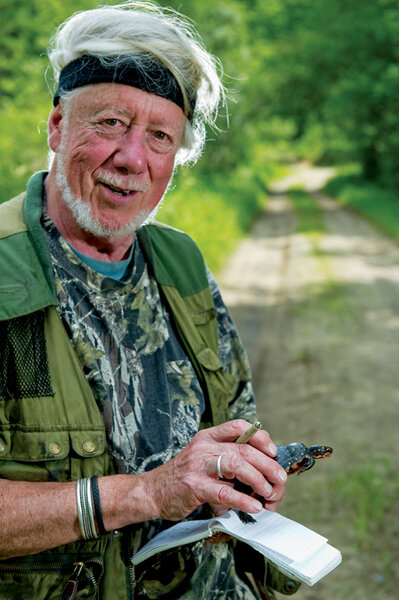David Carroll tracks turtles to reveal what nature has to say to humans
Loading...
| Warner, N.H.
The glossy knob of the head of a spotted turtle peeks out from a vernal pool. Seen from 10 feet away, its tiny eyelid throws a flick of light as it closes.
"Blink," David Carroll says, with a quietness and adoration he might use to speak to a napping baby. "They can disappear in here so fast, it's really hard to get your hands on them."
It has been a rainy May in Warner, N.H., ideal for turtle spotting. Turtle season began a little late this year, April 3, when ice receded in the ponds, and Mr. Carroll saw his first turtle from his snowshoes.
Now that the season is in full swing, he'll come out almost every day to observe spotted and wood turtles until they go back into hibernation in October.
For more than 30 years, Carroll has followed the same turtle-tracking routine on this 1,000-acre piece of land near his home. He records details of the turtles and their nests. When he finds a new turtle, he'll pluck it up and file small notches on its shell to mark it.
Despite the large amount of data that Carroll has accumulated, he's made relatively small contributions to the field of biology. He's helped graduate students with thesis projects, and he's given away some records to other biologists. But he hasn't published any papers of his own.
"I could never do the right kind of number crunching, statistical analysis," Carroll says.
Instead, Carroll is known for the five books he's written and illustrated about turtles, natural history, and his life.
His most recent, "Following the Water" (2009), follows Carroll as he looks for turtles in the woods. It was a nonfiction finalist for a National Book Foundation medal.
He received his biggest honor in 2006: a MacArthur Foundation "genius" grant worth $500,000.
As a self-taught field biologist but an artist by training, with degrees from the School of the Museum of Fine Arts in Boston and Tufts University, his science, art, and writing inform each other deeply.
He draws both reptiles and humans with anatomical precision and poetic whimsy – crisp turtles laid neatly over silky, pink water-color leaves; longhaired women copied carefully from photographs, sketched on gold-stamped paper.
His painterly prose about wandering in swamps is twinned with acute scientific observation and laced with personal philosophy.
His literary and artistic approach to science has inspired the theme for an annual field trip at Berwick Academy in South Berwick, Maine. Carroll visited the school several years ago. Ever since, the seventh-grade class goes to a nearby nature reserve to write, draw, and conduct science experiments each year.
In March the New Hampshire Science Teachers' Association recognized Carroll by giving him an award usually given to the outstanding science teacher in the state.
Carroll's work has a wide appeal. Earl Fleegler, a surgeon who lives in Ambler, Pa., has been reading Carroll's books for years.
"He's such a good storyteller," Dr. Fleegler says. "It's a pleasure to read, but in this very nice way, you're learning all these different things about biology."
Fleegler, himself an outdoorsman and artist, says Carroll's books have inspired him to learn more about the plants and animals he sees and to respect their environments. He's also more inclined to paint scenes he finds in the woods now.
"Following the Water" – a serene and informative book – becomes heartbreaking when Carroll describes people destroying natural habitats.
In conversation, Carroll is gregarious, with an inventory of well-tested anecdotes. But he becomes earnest and pleading when he describes how construction projects and human recreation are ruining the homes of wildlife.
In the past, he's conducted investigations for the US Environmental Protection Agency, the US National Park Service, and endangered species programs, and he's been a political advocate for environmental preservation.
He would like to see more pieces of land sealed off from human use and left as they are.
"These natural landscapes have a right to exist, under their own terms, not for their [use to] mankind," Carroll says.
Most of his time is spent working on projects that he'll never use or finish. His studio walls are masked with artwork that may never be framed or hung in a gallery. He studies Spanish, Italian, Russian, and German with academic rigor, but he almost never leaves New Hampshire.
His rich data set on the turtles fills hundreds of notebooks, stashed away in boxes in his house, piled up or shoved under pieces of furniture.
He offers a few flimsy explanations about why he bothers keeping the data at all. Maybe someday, he muses, someone else will be able to use it for research.
But such loose ends don't bother him.
"What good is it to be alive on earth and never come to know at least the place where one lives?" Carroll asks in "Following the Water." "We don't even try to know it with our senses, much less with our minds and spirits."





